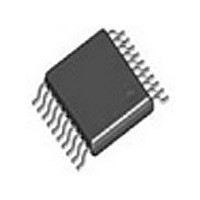LM4884MHX/NOPB National Semiconductor, LM4884MHX/NOPB Datasheet - Page 18

LM4884MHX/NOPB
Manufacturer Part Number
LM4884MHX/NOPB
Description
IC AMP AUDIO 2.6W STER 20TSSOP
Manufacturer
National Semiconductor
Series
Boomer®r
Type
Class ABr
Datasheet
1.LM4884MHXNOPB.pdf
(22 pages)
Specifications of LM4884MHX/NOPB
Output Type
2-Channel (Stereo)
Max Output Power X Channels @ Load
2.6W x 2 @ 3 Ohm
Voltage - Supply
3 V ~ 5.5 V
Features
Depop, Differential Inputs, Shutdown, Thermal Protection
Mounting Type
Surface Mount
Package / Case
20-TSSOP Exposed Pad, 20-eTSSOP, 20-HTSSOP
Operational Class
Class-AB
Audio Amplifier Output Configuration
2-Channel Stereo
Output Power (typ)
2.6x2@3OhmW
Audio Amplifier Function
Speaker
Total Harmonic Distortion
0.3@4Ohm@2W%
Single Supply Voltage (typ)
5V
Dual Supply Voltage (typ)
Not RequiredV
Power Supply Requirement
Single
Rail/rail I/o Type
No
Power Supply Rejection Ratio
62dB
Single Supply Voltage (min)
3V
Single Supply Voltage (max)
5.5V
Dual Supply Voltage (min)
Not RequiredV
Dual Supply Voltage (max)
Not RequiredV
Operating Temp Range
-40C to 85C
Operating Temperature Classification
Industrial
Mounting
Surface Mount
Pin Count
20
Package Type
TSSOP
Lead Free Status / RoHS Status
Lead free / RoHS Compliant
Other names
LM4884MHX
www.national.com
Application Information
The design begins by specifying the minimum supply voltage
necessary to obtain the desired output power. One way to
find the minimum supply voltage is to use the Output Power
vs Supply Voltage curve in the Typical Performance Char-
acteristics section. Another way, using Equation (6), is to
calculate the peak output voltage necessary to achieve the
desired output power for a given load impedance. To ac-
count for the amplifier’s dropout voltage, two additional volt-
ages, based on the Dropout Voltage vs Supply Voltage in the
Typical Performance Characteristics curves, must be
added to the result obtained by Equation (6). The result is
Equation (7).
The Output Power vs Supply Voltage graph for an 8Ω load
indicates a minimum supply voltage of 4.6V. This is easily
met by the commonly used 5V supply voltage. The additional
voltage creates the benefit of headroom, allowing the
LM4884 to produce peak output power in excess of 1W
without clipping or other audible distortion. The choice of
supply voltage must also not create a situation that violates
of maximum power dissipation as explained above in the
Power Dissipation section.
After satisfying the LM4884’s power dissipation require-
ments, the minimum differential gain is found using Equation
(8).
Thus, a minimum gain of 2.83 allows the LM4884’s to reach
full output swing and maintain low noise and THD+N perfor-
mance. For this example, let A
the gain will be set to 10dB (A
low to GAIN 0 and a logic high to GAIN 1.
The last step in this design example is setting the amplifier’s
-3dB frequency bandwidth. To achieve the desired
Input Level:
Input Impedance:
Bandwidth:
V
DD
≥ (V
OUTPEAK
+ (V
VD
VD
100 Hz−20 kHz
OD TOP
= 3. In the example design,
= 3.2) by applying a logic
+ V
OD BOT
(Continued)
))
±
0.25 dB
±
1 V
0.25dB
20 kΩ
RMS
(6)
(7)
(8)
18
pass band magnitude variation limit, the low frequency re-
sponse must extend to at least one-fifth the lower bandwidth
limit and the high frequency response must extend to at least
five times the upper bandwidth limit. This extended bandwith
produces a gain variation of -0.17dB at the bandwith’s limits,
well within the
As mentioned in the External Components section, the inter-
nal input resistor and C
amplifier’s lower bandpass frequency limit. Find the coupling
capacitor’s value using Equation (11).
The result is (using the minimum R
correct magnitude response at 20Hz)
Use a 0.39µF capacitor, the closest standard value. The
product of the desired high frequency cutoff (100kHz in this
example) and the differential gain, A
per passband response limit. With A
100kHz, the closed-loop gain bandwidth product (GBWP) is
320kHz. This is less than the LM4884’s 3.5MHz GBWP. With
this margin, the amplifier can be used in designs that require
more differential gain while avoiding performance-restricting
bandwidth limitations.
Recommended Printed Circuit
Board Layout
Figures 2 through 6 show the recommended four-layer PC
board layout that is optimized for the 20-pin MH-packaged
LM4884 and associated external components. This circuit is
designed for use with an external 5V supply and 3Ω (or
higher) speakers (or load resistors).
This circuit board is easy to use. Apply 5V and ground to the
board’s V
speakers (or load resistors) between the board’s -OUTA and
+OUTA and -OUTB and +OUTB pads. Apply balanced dif-
ferential stereo input signals to the input pins labeled "-INA,"
"+INA," "-INB," and "+INB."
and an
DD
and GND terminals, respectively. Connect
±
1/(2π*20kΩ*20Hz) = 0.398µF
0.25dB desired limit. The results are an
f
H
f
f
= 20kHz x 5 = 100kHz
L
-3dB
= 100Hz/5 = 20Hz
i
create a high pass filter that sets the
= 1/2π(20kΩ)C
IN
resistor value to ensure
VD
, determines the up-
VD
I
= 3.2 and f
(10)
(12)
(11)
H
(9)
=











